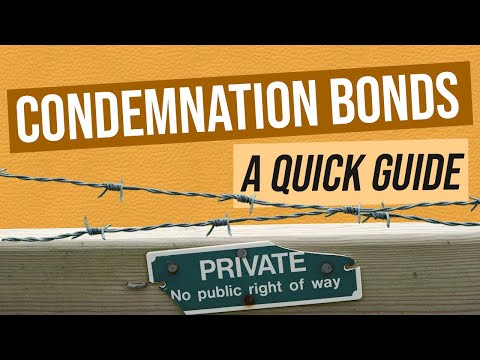Plot twist! In a world where we believe we have ownership rights over every brick and bolt of our property, there’s a concept called ‘condemnation in real estate’. Get ready for an engaging jaunt through the lesser-explored alleyways of real estate history and principles as we delve into condemnation, eminent domain, and the impact of these facets on the everyday homeowner. We’ll tackle what happens to your house when it’s condemned and how to handle potential condemnation scenarios as we set about understanding the nuts and bolts of this legal conundrum.
Grasping the Concept of Condemnation in Real Estate
To first understand condemnation in real estate, we must grasp what it refers to. So, What Does condemn mean anyway? When a local, state, or federal government seizes your private property – with the intention to convert it for public use – and compensates for its worth, they are said to have ‘condemned’ your property.
This process is closely tied to a legal concept known as ‘Eminent Domain’. The right of the government to take private property for public use underlines the principal role played by eminent domain in the realm of condemnation. Rooted deeply in the constitution, the Fifth Amendment ensures that the government must compensate the ‘condemned’ landowners justly.
Let’s take a closer look at the basic legal and procedural framework around condemnation. Herein, comes the technical element. The condemnation process in some states, like Texas, follows a two-phase litigation process, starting with a Special Commissioners’ Hearing. This involves the hearing of evidence and arguments by three commissioners appointed by the court. The commissioner’s duty lies in determining a compensatory amount for the landowner.
The concept may seem strange and even unfair to many, but understanding it is vital, especially in the world of real estate. Keep reading as we trace the origins of this principle and its evolution over the years.

Tracing the History and Evolution of Condemnation
Key historical milestones in Condemnation and Real Estate Law underpin the road this principle has traversed.
During the early civilization era, the power of eminent domain was used by rulers to seize property for public use. Flash forward to modern times, the concept of eminent domain was adopted as the Fifth Amendment of the U.S. Constitution in 1791, according the government the right to private property for public use, provided just compensation is offered. This laid the foundation for what we now understand as ‘condemnation in real estate’.
Recent years have brought about Changes to Condemnation Procedures and Regulations in the US. As time ticking away, various shifts have occurred, creating nuances in the process and bolstering the requirements for government institutions executing land seizures.
Court judgments shaping Condemnation Laws have also significantly influenced the interpretation and application of condemnation procedures. Landmark cases such as Kelo v. City of New London have had a rippling effect on the way condemnation is viewed and performed.
The process of condemnation is the painting of a bigger picture encompassing the relationship between citizens, real estate law, and legal histories, and their collective effect on contemporary society.

| Aspect | Description |
|---|---|
| Definition | Condemnation in real estate refers to the process by which a government agency seizes private property from an owner and compensates that owner for the property. |
| Relationship with Eminent Domain | Condemnation is the process by which the right of eminent domain, the government’s right to take private property and convert it to public use, is exercised. |
| Legal Roots | The process of condemnation is rooted in the U.S. Constitution. The Fifth Amendment requires that landowners receive “just compensation” for their property. |
| Process in Texas | In Texas, condemnation is a two-phase litigation process starting with a Special Commissioners’ Hearing, where three court-appointed commissioners determine compensation for the landowner. |
| Building Condemnation | A dangerous building may be sealed up and deemed uninhabitable through an act of condemnation, implying that the building is no longer fit for use. |
| Mortgage Clause | The condemnation clause in a mortgage gives the mortgage holder the right to all proceeds to be paid in the condemnation case, up to the amount owed on the mortgage. |
| Equity Calculation in Mortgage Condemnation | If the process is based on a calculation related to the equity in the property, the bank cannot take more than is owed on the mortgage. |
| Effective Date | As an example, this process was highlighted on April 7, 2023. |
Identifying a Condemned House and Understanding its Implications
So, how might one identify a condemned house? Certain tell-tale signs point towards potential condemnation. These range from severe structural issues to health hazards, and can escalate to a stage where the house is deemed uninhabitable through an act of condemnation real estate.
For homeowners and occupiers, a condemned house ramifications are extensive. The property value takes a rather distressing hit, leading to significant financial impact, earning it the descriptor as another word For poor in the real estate world. The marketability of the property is equally affected, making it remarkably difficult to sell.
One harsh reality that homeowners must grapple with is the clause that gives the mortgage holder all proceeds payable in a condemnation case up to the amount owed on the mortgage. The financial ramifications can be profound, but as Sigourney Weaver said, “Don’t be afraid to feel as angry or as loving as you can.” In other words, it’s essential to confront these issues head-on.

The Process of Condemnation in Real Estate: Deeper Insights
Let’s delve into the gritty details that mark the condemnation process. Hint, it’s a lot more than just government power plays.
From inception to execution, the road to condemnation is fraught with legal formalities and procedures. Steps in the condemnation process involve appraisal, negotiation, condemnation proceedings, and even potential appeals. Each step requires expert handling and patience.
In this process, both government officials and legal advisers become key players in a Condemnation process, handling negotiations, paperwork, hearings, and legal challenges. Even caraway cookware doesn’t heat up as intensely as these court proceedings can.
Let’s consider a real-life example of Condemnation processes. Take the case of Love Field, a small airport in Texas. Under eminent domain authority, the city of Dallas utilized condemnation proceedings to acquire land for expansion. This case reflects the complexity and intricate nature of the condemnation process, showcasing how unique the process can be based upon circumstances.

Navigating Eminent Domain: For Property Owners and Occupiers
As a property owner, hearing the word ‘condemnation’ might make you feel like the walls are closing in. Fear not! Knowing your rights and options can make the process a lot less daunting.
First things first, understand your rights during a condemnation process. You have the right to seek fair compensation and negotiate the proposed value for the property. If you don’t agree with the compensation offer, you can refuse. Remember, even in such situations, the principle of right Of refusal applies.
When it comes to legal resources and options, consider seeking the help of a real estate attorney or joining hands with a community facing similar issues. Establishing a living trust or a family trust is also an option, as these can add protection to your property and maybe even dodge a bullet or two.
How about dealing with eminent domain disputes? While negotiation is a key strategy, sometimes, it takes more than a friendly chat. Legal action could be your bet in ensuring just compensation. As in the world of Rocket Power**, achieving victory sometimes requires a strategic approach, teamwork, and a fiery spirit.

The Bigger Picture: Economic and Social Impact of Condemnation
We can’t deny the magnitude of the repercussions that prevail long after a home has been condemned. The economic effects of condemnation and land repossession are considerable. Property values in entire neighborhoods may decline temporarily. In some cases, depending on the public project, long term property values may even increase, making it an equal definition of a real estate roller-coaster ride.
The socio-cultural impacts surrounding widespread condemnation are also worth noting, especially if numerous residents are displaced. Communities can be fragmented and the cultural fabric disrupted. It is important to address these issues with an empathetic lens. Because in the end, we’re all just trying to find our place in this world.
Does condemnation echo the same impact worldwide? The effects are as diverse as the global real estate regulations themselves. Policies differ from country to country. For instance, under Bienes Raices (real estate in Spanish), Mexican law also includes regulations similar to eminent domain, though the specifics might vary.

Wrapping Up: Owning the Future Amidst Condemnation
Like the Curtailed edges of a stick-built home, coping with the threat of condemnation requires precise planning and efficient strategies.
The future of condemnation is inextricably linked to real estate trends. Whether it’s the wave of urbanization or the undertow of gentrification, changes in city structures and preferences will continue to dictate the landscape of condemnation.
Preparing for potential Condemnation scenarios can involve multiple practical strategies. An understanding of real estate laws, maintenance of your property, community collaborations, and proactive engagement with urban development projects can go a long way in mitigating condemnation risks.
Always remember – regardless of the circumstances, the world is full of opportunities. So, how to turn a Condemnation disadvantage into an advantage? Be flexible! Consider alternatives such as reinvestment in promising new areas, harnessing the potential value increase after public projects completion, and even leveraging the situation to negotiate better compensation. Because at the end of the day, it’s not what life throws at you, it’s what you make of it.
In the saga of real estate, we hope this piece helped you understand ‘condemnation in real estate’ better. Do keep in mind, knowledge is power, and staying informed could be the master-key to your real estate adventures.
What is an example of condemnation?
Whew, what a question! To put it simply, condemnation usually happens when a local government entity declares a property unfit for use or living due to any variety of reasons, such as severe damage, health concerns or hazards.
Now, you might ask, ‘what’s the difference between condemnation and eminent domain?’ Well, picture this. Condemnation is like the local authorities telling you your house is a disaster and it’s not safe. Eminent domain, meanwhile, is when the government says they need your land for public use—like for a highway, a park, or a public building—and they’ve got the legal right to buy it from you, whether you wish to sell it or not.
What is the difference between condemnation and eminent domain?
Talking about condemnation in a contract, it basically refers to a situation where the government has the right to purchase private property for public use – that’s under the law, or you could say ‘by the book.’
What is the meaning of condemnation in a contract?
Right, moving onto a condemnation clause in a mortgage. It’s that part of the contract that states if the property you’re using your mortgage to buy gets condemned, the lender gets to use the proceeds to pay off the mortgage first. Sort of a first dibs situation, if you know what I mean.
What is a condemnation clause in a mortgage?
As for condemnation in property, it’s like being the last one picked in a baseball game because there’s something seriously wrong. It means the property has been declared unfit for use, usually because of serious issues or hazards.
What does condemnation mean in property?
Well, in real estate, an example of condemnation might be when an older structure is identified as a hazard and forced to vacate until safety improvements are made. Imagine that dilapidated mansion on the edge of town that’s supposedly haunted – that’s your prime example.
What is an example of condemnation real estate?
Let’s talk some bad examples of eminent domain, shall we? Picture this, a small town had to give up homes and community spaces for a shopping mall that didn’t particularly benefit the public much. Now, that didn’t go down well!
What are the bad examples of eminent domain?
In contrast, good examples of eminent domain could be when land is taken for a new school or a public highway. That’s something everyone can get behind, right?
What are some examples of eminent domain?
Arguing against eminent domain? What a pickle! The best bet is to hire a pro, a good attorney. You might also want to build a case showing the private loss outweighs the public gain – it’s a tough nut to crack but certainly not impossible.
How do you argue against eminent domain?
Okay, let’s rock and roll with terms now. Condemnation is also known as taking. Now, don’t let the term throw you off, it’s just another word in the lingo.
What is condemnation also known as?
Another word for condemnation? You can also use terms like censure, criticism, or disapproval, all fancy-schmancy talk, but they all mean pretty much the same thing.
What is another word for condemnation mean?
Condemnation in one word? I’d probably go with ‘disapproval.’ Simple as that.
What does condemnation mean in one word?
Right, now, what does condemnation mean for dummies? It’s like getting told off in no uncertain terms, for a piece of property, it’s being declared ‘unfit for use’.
What does condemnation mean for dummies?
Now, folks always wonder, ‘who gets condemnation proceeds?’ While you could think it’s a bit of a free-for-all, it’s actually pretty close-knit. The mortgage lender is the first in line to get the money, and if there’s any leftover, then the property owner gets a slice of the pie.
Who gets condemnation proceeds?
Condemnation: positive or negative? 99 times out of 100, it’s negative. No one wants to hear that something they own isn’t up to snuff, right?
Is a condemnation positive or negative?
On a bit of a higher note, God says about condemnation in the Bible that there is no condemnation for those who are in Christ Jesus (Romans 8:1). That’s a kind of hopeful message, isn’t it?
What does God say about condemnation?
And biblically speaking, condemnation refers to the divine verdict upon the wicked, the just penalty for their sins. It’s sort of like falling out of favor or breaking the rules, in a big way.
What does condemnation mean biblically?
People always want to get to the root cause of condemnation, don’t they? Most times it’s due to the property being unsafe or unfit for use – it’s like getting a huge, glaring ‘fail’ on a test.
What is the root cause of condemnation?
Finally, what does it mean to condemn a person? Well, to condemn someone is like seriously telling them off, but in a formal way. It means to express strong disapproval of their actions or behavior.



